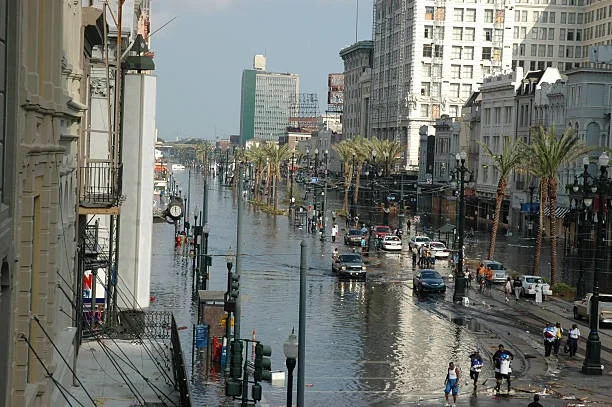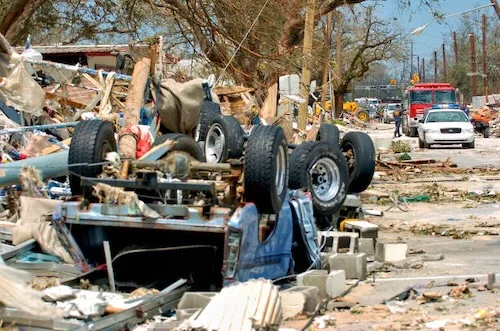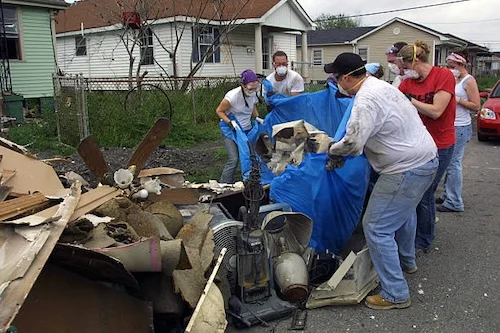We’re living in a time when crises seem to cascade daily. It’s easy to forget that some wounds never fully heal.
Yet for the people of New Orleans, the past isn’t past.
Nearly two decades after Hurricane Katrina’s waters receded, the trauma remains. IN fact, it’s still flowing through generations like an invisible current, shaping everything it touches.
Residents of New Orleans’ most affected neighborhoods, like Tremé, are now more vulnerable to “deaths of despair” – suicide, overdose, and chronic illness linked to hopelessness – than 99% of all American neighborhoods.
Louisiana holds the grim distinction of being the state most vulnerable to these deaths. But numbers alone can’t capture the weight of collective grief. And here at AlignUs, we are committed to helping individuals and their communities grow and and heal from their past traumas
This is the story of a city still learning to breathe underwater, and why a mental health platform in New Orleans isn’t just needed – it’s essential for survival.
The Anatomy of Collective Trauma
Hurricane Katrina didn’t just destroy buildings. It shattered the collective psyche of a city.
The official death toll reached nearly 2,000, but the true casualties extend far beyond those numbers.
Approximately 1.5 million residents were displaced, with 80% of New Orleans submerged. The Lower Ninth Ward and Seventh Ward, predominantly Black neighborhoods built on vulnerable clay soil near the Mississippi River, were obliterated.
But what made Katrina uniquely traumatic wasn’t just the hurricane itself—it was the betrayal. The levees failed. The government failed. The promise that infrastructure would protect citizens failed.
A CDC assessment in October 2005 found that over 50% of returning residents needed mental health treatment, showing signs of anxiety, PTSD, and depression. Five years later, studies showed the rate of probable serious mental illness had doubled.
The city lost more than half its mental health professionals in the storm’s aftermath, and suicide rates nearly tripled.
Generational Transmission: Trauma in the DNA
Children who survived Katrina displayed immediate trauma responses – including panic attacks, hypervigilance, nightmares of rising water.
Now, as adults, many exhibit ongoing anxiety, depression, and PTSD that they’re unknowingly passing to their own children.
Trauma alters gene expression through epigenetic changes, literally rewriting how stress hormones are produced and regulated across generations.
The concept of “anniversary reactions” compounds this generational trauma. Every hurricane season, every heavy rain, every emergency siren triggers the body’s alarm system.
Parents who survived Katrina now watch their children experience anxiety they can’t fully explain – a fear inherited from a storm they never lived through.
This is why a mental health platform in New Orleans must address not just individual trauma but intergenerational healing.
Compound Trauma: When Disasters Never Stop
But Katrina wasn’t an endpoint. It marked the beginning of a cascading series of crises.
Hurricane Isaac in 2012, Hurricane Ida in 2021 (the strongest storm in Louisiana history), countless tornadoes, winter storms, and then COVID-19 hitting an already traumatized population.
Each new disaster doesn’t just add trauma; it multiplies it, reopening wounds before they can heal.
The violence that followed adds another layer. As social networks shattered and economic opportunities vanished, crime increased.
Louisiana led the nation in murder rates for 31 consecutive years between 1980 and 2021. The trauma isn’t from one source, but from living in a constant state of threat, where the next crisis is always on the horizon.
The Perfect Storm of Despair
New Orleans sits in a bowl below sea level, sinking further each year. But not all neighborhoods face equal risk.
The same communities devastated by Katrina (predominantly Black, low-income areas) remain most vulnerable to flooding.
This isn’t a coincidence; it’s environmental racism embedded in city planning, where certain lives are deemed more worthy of protection than others.
Living with this constant threat creates what psychologists call “anticipatory trauma”—the stress of waiting for the next disaster.
Every hurricane season brings not just weather but existential dread.
Climate anxiety in a sinking city isn’t abstract; it’s the daily reality of wondering whether your home, your neighborhood, your entire community will exist next year.
This ongoing environmental stress makes traditional mental health interventions insufficient – any mental wellness platform in New Orleans must address the intersection of climate trauma and racial injustice.
Social Fabric Torn Apart: The Diaspora of Despair
Katrina didn’t just destroy houses – it destroyed families and social and cultural realities.
Cultural traditions, gathering places, and support networks that had sustained communities through centuries of hardship disappeared.
This social fragmentation creates what researchers call “social death” – the loss of identity, belonging, and purpose that comes from severed community ties.
Without these connections, individual trauma becomes unbearable. The mutual aid networks, second-line parades, and neighborhood gatherings that once provided informal mental health support are gone, leaving people isolated with their pain.
Deaths of Despair: The Final Toll
The term “deaths of despair” emerged in the late 1990s to describe fatalities from suicide, addiction, and chronic diseases linked to hopelessness.
Initially affecting white Americans most, these deaths among Black Americans have now surpassed white rates – a shift directly linked to accumulated trauma and systematic abandonment.
Recent research analyzed 184 social and environmental metrics across 70,000 neighborhoods.
Their findings? Louisiana residents face the highest vulnerability to deaths of despair in the nation. In Tremé, residents are more vulnerable to these deaths than 99% of American neighborhoods.
Another study revealed that Black people experience mortality increases for up to 15 years after hurricanes, three times higher than white populations exposed to the same storms.
This isn’t because hurricanes hit Black communities harder initially, but because of the compounding challenges that follow: less money, fewer resources, worse healthcare, and chronic stress that accumulates over decades.
These disparities make clear why the best mental health platform in New Orleans must center racial equity and long-term support.
The Healing Response
So, what’s the solution? It’s multifaceted – and it starts with addressing the issues head-on.
The New Orleans Health Department has implemented trauma-informed initiatives, while schools have expanded mental health programs.
The ratio of mental health providers in New Orleans (340:1) beats the national average (500:1). Yet, approximately 38% of Louisiana adults with mental illness receive any treatment, below the national average and inadequate for the scale of need.
Local hospitals have adopted trauma-informed care models, recognizing that physical and mental health are inseparable. Telehealth expansions during COVID-19 created new access points, particularly for those in underserved areas.
But these institutional responses often fail to address root causes – treating symptoms while the underlying disease persists.
Cultural Healing Practices
New Orleans’ survival secret has always been its culture – and that’s where so much of the healing comes from.
The city’s history of resilience and resistance, combined with its vibrant music, art, and food scenes, provides a unique backdrop for cultural healing practices.
Music therapy programs use jazz, bounce, and brass bands to process trauma through rhythm and movement. The Mardi Gras Indians preserve not just traditions but identity, using masking as a form of resistance and resilience.
These cultural practices aren’t separate from mental health—they’re essential to it. Any effective mental health platform in New Orleans must integrate, not replace, these indigenous healing modalities. Technology should amplify culture, not erase it.
Innovation and Technology
While traditional therapy remains inaccessible for many, digital solutions are emerging. Telehealth expanded during the COVID-19 pandemic, reaching previously isolated communities.
Crisis hotlines adapted to text messaging, meeting younger generations where they communicate. Apps focused on trauma-specific interventions provide coping strategies between therapy sessions.
But technology alone isn’t enough. The most promising innovations blend digital accessibility with cultural competence.
A mental health platform in New Orleans that understands jazz as therapy, that recognizes anniversary reactions during hurricane season, that connects users to both licensed therapists and community healers – this hybrid model could bridge the gap between need and resources.
The key is ensuring technology amplifies rather than replaces human connection. Automated chatbots can’t hold space for grief. Algorithms can’t understand what it means to lose your grandmother’s house – where four generations gathered.
But technology can connect survivors across the diaspora, preserve healing traditions, and make culturally competent care accessible to those who’ve been historically excluded.
The Path Forward
Individual therapy cannot heal collective trauma. It requires a communal movement.
Mental health interventions that ignore poverty, environmental racism, and ongoing displacement treat symptoms while the disease spreads.
True healing requires addressing root causes: investing in flood protection for all neighborhoods, not just wealthy ones; creating economic opportunities that provide dignity along with income; rebuilding social infrastructure that reconnects scattered communities.
Prevention must precede crisis. Waiting until someone reaches the breaking point is too late. Schools need trauma-informed education starting in kindergarten.
Workplaces need mental health resources as standard as health insurance. Communities need gathering spaces where connection happens naturally, where isolation can’t take root.
A New Model for Support
The future of mental health support in New Orleans can’t replicate failed models from elsewhere. It must emerge from the city’s own wisdom, honoring both pain and resilience.
This means integrating traditional therapy with cultural practices, combining individual healing with community restoration, and addressing trauma while fighting its ongoing sources.
A mental wellness platform in New Orleans designed by and for New Orleanians would look different from anything Silicon Valley might create.
It would recognize that healing happens in second lines and church pews as much as therapy offices. It would also know that processing trauma might mean making music, cooking traditional foods, or simply sitting in silence with others who understand without explanation.
Most importantly, it would center those most affected – Black residents, low-income communities, those still displaced – as experts in their own healing rather than passive recipients of others’ interventions.
Their voices, not distant funders or outside experts, must guide what recovery looks like.
Making Mental Health Accessible to All
Accessibility means more than affordability.
It means therapy in languages besides English, acknowledging New Orleans’ diverse communities. It means providers who understand that missing an appointment might mean choosing work over healing, not resistance to treatment.
The best mental health platform in New Orleans would meet people where they are – physically, emotionally, culturally.
This might mean therapists in barbershops, support groups in churches, or crisis intervention at jazz festivals. It means working with existing community structures rather than imposing new ones, amplifying indigenous wisdom rather than importing foreign solutions.
Insurance reform is essential. Medicaid reimbursements that don’t cover therapists’ basic expenses guarantee that those most needing help can’t access it.
But beyond policy changes, we need imagination – new models that bypass broken systems entirely. Community therapy funds, sliding scales based on neighborhood rather than individual income, mutual aid approaches that recognize healing as a collective responsibility.
The Storm Continues – But We Can Find The Sunlight
Twenty years after Katrina, New Orleans remains in active trauma. The storm never really ended; it transformed into poverty, violence, displacement, and despair that continue claiming lives.
Yet New Orleans also remains undefeated. In Thursday night healing circles, in second lines that refuse to stop, in young people who transform trauma into art, the city demonstrates that survival isn’t just enduring – it’s insisting on joy despite everything trying to steal it.
This resilience isn’t romantic; it’s rebellion against a system content to let Black communities drown, literally and metaphorically.
Here at AlignUs, we’re building an online platform to connect and uplift those fighting for justice and change. Together, we can create a storm of our own – one that brings healing and hope instead of destruction.
Ready to be part of the solution? AlignUs is building a new model for mental health support that honors both individual and collective healing.
Join us in creating platforms that don’t just treat trauma but transform the conditions that create it.
Because New Orleans doesn’t need saving – it needs justice, resources, and recognition that its wounds are America’s wounds, and its healing is essential for us all.




